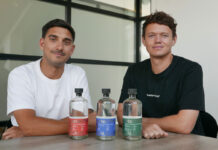Beer introduced to Scotland earlier this year traces its roots to 12th century

AUTHENTICITY has become a watchword in the drinks market in recent years, and beer arguably doesn’t get any more authentic than when it is brewed in Belgium, by a Belgian, using traditional Belgian ingredients and techniques.
And that’s exactly the proposition that Tennent’s owner C&C Group has brought to the Scottish on-trade with recently-launched Belgian abbey beer Heverlee.
I literally knocked on the door of the abbey and asked the monk why they had no beer in their portfolio.
The brainchild of brewer and native Belgian Joris Brams, Heverlee was launched earlier in the year, with plans to roll it out to further territories in Europe and across the world in the coming months.
Brams, whose career has included a stint working for Scottish & Newcastle, grew up just two miles away from the Heverlee Abbey, near Leuven, and was determined to create a beer in the traditional Belgian style.
“I live in Belgium and was born in Leuven and I saw so many good brewers in Belgium and good stories and there was one missing, and that was Heverlee,” Brams told SLTN.
“I literally knocked on the door of the abbey and asked the monk why he has no beer in his portfolio, since every other abbey in Belgium has beers, some of which have become world famous with big brewers.”
The monks at the abbey seemed to take the point, as they agreed not only to the use of the Heverlee name, but gave Brams full access to the abbey’s historical records.
“There are a lot of monasteries that claim big [beer] names when there was never actually any sign of a brewery whatsoever,” said Brams.
“With Heverlee this is different.
“What we found in the library is that there was actually a brewing operation, and the first mill installed in the abbey in the 12th century.”
Although the brewery at the monastery closed a long time ago, plans are already underway to restore and reopen it. The project will be partially funded by royalties from the sale of Heverlee and partly through a sizeable European grant.
In the meantime the beer is being produced in a nearby brewery, under Brams’ watchful eye, and using a brewing process that is said to be slower and more traditional than those used in larger-scale beer brands.
The project has been a labour of love for Brams, and not necessarily one that was undertaken from a purely commercial perspective.
The brewing operation in the abbey dates back to the 12th century.
“We said ‘let’s do something now by linking all of that authenticity to a brewer I know, and let’s start from scratch with what we think was available in the Middle Ages from raw materials, and let’s do something where we completely disregard productivity and completely disregard consumer tastes’,” said Brams.
“We’ve not done any research whatsoever.
“No complaints, no marketing stories, it’s a bit of a hobby and a bit of a heritage story that I wanted to bring back to life.”
And Brams is adamant that the beer will retain its provenance going forward.
“We’ll never brew Heverlee in Wellpark (home of Tennent’s Lager),” he said.
“I could, but why should I? It kills the story. With Heverlee we don’t want to go that way.”
Marketing activity for the beer has included sampling sessions in Glasgow and Edinburgh – including some in barbers and bike shops – as well as in-outlet training promoting the perfect serve of Heverlee, which involves ‘beheading’ the beer in the traditional continental style.



















